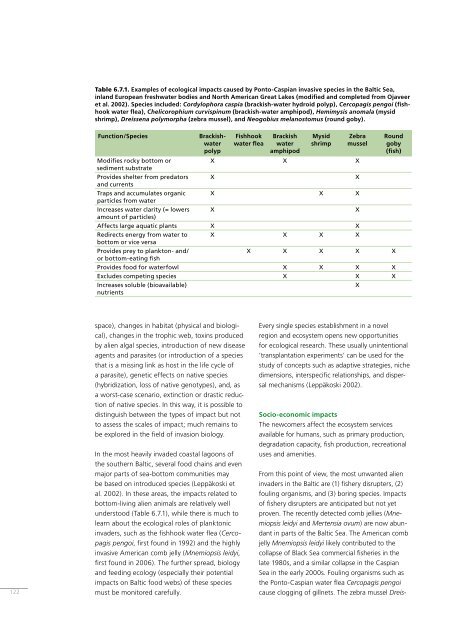BSEP116B Biodiversity in the Baltic Sea - Helcom
BSEP116B Biodiversity in the Baltic Sea - Helcom
BSEP116B Biodiversity in the Baltic Sea - Helcom
Create successful ePaper yourself
Turn your PDF publications into a flip-book with our unique Google optimized e-Paper software.
Table 6.7.1. Examples of ecological impacts caused by Ponto-Caspian <strong>in</strong>vasive species <strong>in</strong> <strong>the</strong> <strong>Baltic</strong> <strong>Sea</strong>,<br />
<strong>in</strong>land European freshwater bodies and North American Great Lakes (modified and completed from Ojaveer<br />
et al. 2002). Species <strong>in</strong>cluded: Cordylophora caspia (brackish-water hydroid polyp), Cercopagis pengoi (fishhook<br />
water flea), Chelicorophium curvisp<strong>in</strong>um (brackish-water amphipod), Hemimysis anomala (mysid<br />
shrimp), Dreissena polymorpha (zebra mussel), and Neogobius melanostomus (round goby).<br />
Function/Species<br />
Brackishwater<br />
polyp<br />
Fishhook<br />
water flea<br />
Brackish<br />
water<br />
amphipod<br />
Mysid<br />
shrimp<br />
Zebra<br />
mussel<br />
Modifies rocky bottom or<br />
X X X<br />
sediment substrate<br />
Provides shelter from predators X<br />
X<br />
and currents<br />
Traps and accumulates organic X X X<br />
particles from water<br />
Increases water clarity (= lowers X<br />
X<br />
amount of particles)<br />
Affects large aquatic plants X X<br />
Redirects energy from water to X X X X<br />
bottom or vice versa<br />
Provides prey to plankton- and/<br />
X X X X X<br />
or bottom-eat<strong>in</strong>g fish<br />
Provides food for waterfowl X X X X<br />
Excludes compet<strong>in</strong>g species X X X<br />
Increases soluble (bioavailable)<br />
nutrients<br />
X<br />
Round<br />
goby<br />
(fish)<br />
122<br />
From this po<strong>in</strong>t of view, <strong>the</strong> most unwanted alien<br />
<strong>in</strong>vaders <strong>in</strong> <strong>the</strong> <strong>Baltic</strong> are (1) fishery disrupters, (2)<br />
foul<strong>in</strong>g organisms, and (3) bor<strong>in</strong>g species. Impacts<br />
of fishery disrupters are anticipated but not yet<br />
proven. The recently detected comb jellies (Mnemiopsis<br />
leidyi and Mertensia ovum) are now abundant<br />
<strong>in</strong> parts of <strong>the</strong> <strong>Baltic</strong> <strong>Sea</strong>. The American comb<br />
jelly Mnemiopsis leidyi likely contributed to <strong>the</strong><br />
collapse of Black <strong>Sea</strong> commercial fisheries <strong>in</strong> <strong>the</strong><br />
late 1980s, and a similar collapse <strong>in</strong> <strong>the</strong> Caspian<br />
<strong>Sea</strong> <strong>in</strong> <strong>the</strong> early 2000s. Foul<strong>in</strong>g organisms such as<br />
<strong>the</strong> Ponto-Caspian water flea Cercopagis pengoi<br />
cause clogg<strong>in</strong>g of gillnets. The zebra mussel Dreisspace),<br />
changes <strong>in</strong> habitat (physical and biological),<br />
changes <strong>in</strong> <strong>the</strong> trophic web, tox<strong>in</strong>s produced<br />
by alien algal species, <strong>in</strong>troduction of new disease<br />
agents and parasites (or <strong>in</strong>troduction of a species<br />
that is a miss<strong>in</strong>g l<strong>in</strong>k as host <strong>in</strong> <strong>the</strong> life cycle of<br />
a parasite), genetic effects on native species<br />
(hybridization, loss of native genotypes), and, as<br />
a worst-case scenario, ext<strong>in</strong>ction or drastic reduction<br />
of native species. In this way, it is possible to<br />
dist<strong>in</strong>guish between <strong>the</strong> types of impact but not<br />
to assess <strong>the</strong> scales of impact; much rema<strong>in</strong>s to<br />
be explored <strong>in</strong> <strong>the</strong> field of <strong>in</strong>vasion biology.<br />
In <strong>the</strong> most heavily <strong>in</strong>vaded coastal lagoons of<br />
<strong>the</strong> sou<strong>the</strong>rn <strong>Baltic</strong>, several food cha<strong>in</strong>s and even<br />
major parts of sea-bottom communities may<br />
be based on <strong>in</strong>troduced species (Leppäkoski et<br />
al. 2002). In <strong>the</strong>se areas, <strong>the</strong> impacts related to<br />
bottom-liv<strong>in</strong>g alien animals are relatively well<br />
understood (Table 6.7.1), while <strong>the</strong>re is much to<br />
learn about <strong>the</strong> ecological roles of planktonic<br />
<strong>in</strong>vaders, such as <strong>the</strong> fishhook water flea (Cercopagis<br />
pengoi, first found <strong>in</strong> 1992) and <strong>the</strong> highly<br />
<strong>in</strong>vasive American comb jelly (Mnemiopsis leidyi,<br />
first found <strong>in</strong> 2006). The fur<strong>the</strong>r spread, biology<br />
and feed<strong>in</strong>g ecology (especially <strong>the</strong>ir potential<br />
impacts on <strong>Baltic</strong> food webs) of <strong>the</strong>se species<br />
must be monitored carefully.<br />
Every s<strong>in</strong>gle species establishment <strong>in</strong> a novel<br />
region and ecosystem opens new opportunities<br />
for ecological research. These usually un<strong>in</strong>tentional<br />
‘transplantation experiments’ can be used for <strong>the</strong><br />
study of concepts such as adaptive strategies, niche<br />
dimensions, <strong>in</strong>terspecific relationships, and dispersal<br />
mechanisms (Leppäkoski 2002).<br />
Socio-economic impacts<br />
The newcomers affect <strong>the</strong> ecosystem services<br />
available for humans, such as primary production,<br />
degradation capacity, fish production, recreational<br />
uses and amenities.

















